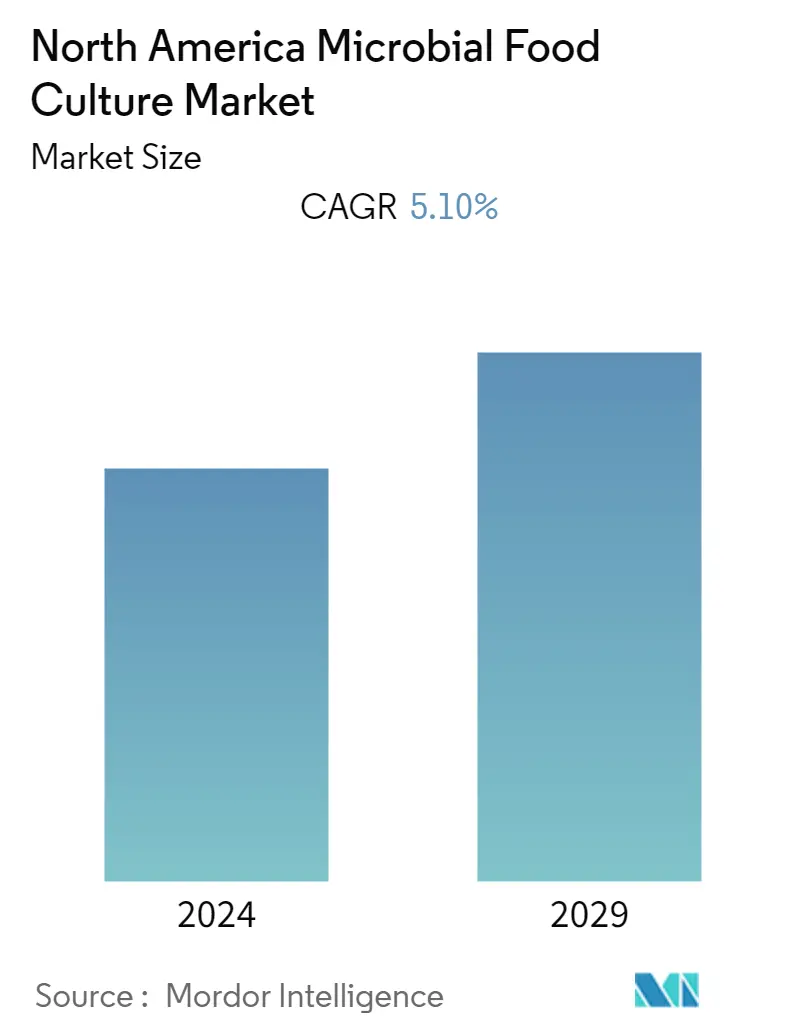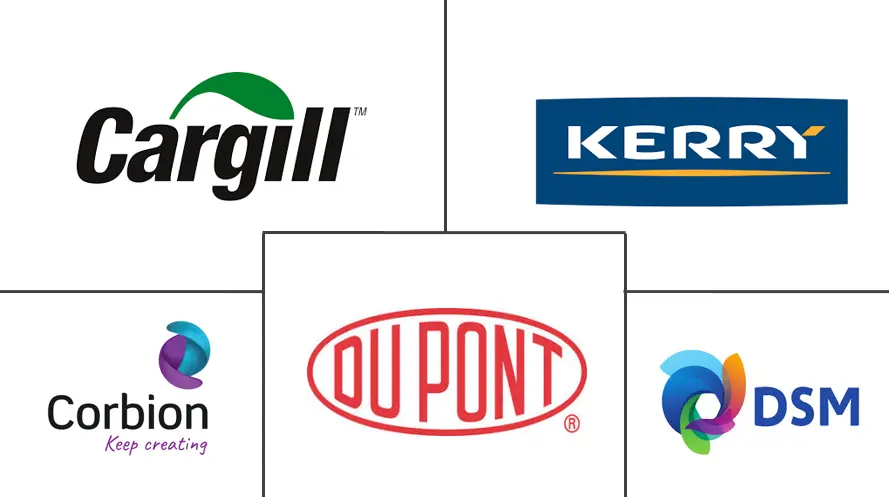Market Size of North America Microbial Food Culture Industry

| Study Period | 2019 - 2029 |
| Base Year For Estimation | 2023 |
| Forecast Data Period | 2024 - 2029 |
| Historical Data Period | 2019 - 2022 |
| CAGR | 5.10 % |
| Market Concentration | High |
Major Players
*Disclaimer: Major Players sorted in no particular order |
North America Microbial Food Culture Market Analysis
The North America microbial food culture market is projected to grow at a CAGR of 5.1% during the forecast period 2020-2025
- The market is majorly driven by the growing consumer demands for functional food and probiotic food supplements, along with the rising awareness regarding the consumption of fermented food products. In addition, its functional properties that improve the overall quality and shelf life of the product without any degradation of sensitive ingredients is expected to further strengthen its demand.
- Furthermore, increasing technological advancement in processing and frequent product launch of new ingredient offerings is expected to propel the microbial food culture market growth in the region.
North America Microbial Food Culture Industry Segmentation
The North America microbial food culture market is segmented by type and its application in end-user industries. By type, the market is segmented into starter cultures, adjunct and aroma cultures, and probiotics; and by application into bakery and confectionery, dairy, fruits and vegetables, beverages, and other end-user industries. Also, the study provides an analysis of the microbial food culture market in the emerging and established markets across North America, including the United States, Mexico, Canada, and the Rest of North America.
| By Type | |
| Starter Cultures | |
| Adjunct and Aroma Cultures | |
| Probiotics |
| By End-Industry | |
| Bakery and Confectionery | |
| Dairy | |
| Fruits and Vegetables | |
| Beverages | |
| Other End-user Industries |
| By Country | |
| United States | |
| Mexico | |
| Canada | |
| Rest of North America |
North America Microbial Food Culture Market Size Summary
The North America microbial food culture market is experiencing significant growth, driven by increasing consumer demand for functional and probiotic food supplements. This demand is fueled by a rising awareness of the benefits of fermented food products, which enhance the quality and shelf life of foods without degrading sensitive ingredients. Technological advancements in processing and the frequent introduction of new ingredient offerings are further propelling market growth. The probiotics segment, in particular, is expected to expand due to a growing focus on healthy lifestyles and the popularity of digestive health supplements. Probiotics, found in foods and beverages like yogurt, fruit juices, and cultured dairy drinks, offer benefits such as immune system stimulation and relief from disorders like diarrhea and lactose intolerance. The demand for yogurt, a major probiotic product, is particularly strong, bolstering the microbial food culture market in the food and beverage industries.
The United States is anticipated to lead the growth in the North American microbial food culture market, driven by changing dietary patterns and a shift towards healthier habits. The high consumption of alcoholic beverages, especially beer, which relies heavily on microbial food culture, further supports market expansion. Additionally, the bakery industry’s increasing demand for yeast culture and the rising consumption of baked goods contribute to market growth. Technological innovations, such as microencapsulation, which enhance the stability and longevity of probiotic bacteria, are also key factors driving the market. The competitive landscape is characterized by a fragmented market with numerous regional and domestic players, with companies focusing on mergers, expansions, acquisitions, and partnerships to strengthen their market presence. Key players in the market include Kerry Group PLC, Koninklijke DSM NV, DuPont de Nemours, Inc., Corbion NV, Cargill, Incorporated, and Lallemand Inc.
North America Microbial Food Culture Market Size - Table of Contents
-
1. MARKET DYNAMICS
-
1.1 Market Drivers
-
1.2 Market Restraints
-
1.3 Porter's Five Forces Analysis
-
1.3.1 Threat of New Entrants
-
1.3.2 Bargaining Power of Buyers/Consumers
-
1.3.3 Bargaining Power of Suppliers
-
1.3.4 Threat of Substitute Products
-
1.3.5 Intensity of Competitive Rivalry
-
-
-
2. MARKET SEGMENTATION
-
2.1 By Type
-
2.1.1 Starter Cultures
-
2.1.2 Adjunct and Aroma Cultures
-
2.1.3 Probiotics
-
-
2.2 By End-Industry
-
2.2.1 Bakery and Confectionery
-
2.2.2 Dairy
-
2.2.3 Fruits and Vegetables
-
2.2.4 Beverages
-
2.2.5 Other End-user Industries
-
-
2.3 By Country
-
2.3.1 United States
-
2.3.2 Mexico
-
2.3.3 Canada
-
2.3.4 Rest of North America
-
-
North America Microbial Food Culture Market Size FAQs
What is the current North America Microbial Food Culture Market size?
The North America Microbial Food Culture Market is projected to register a CAGR of 5.10% during the forecast period (2024-2029)
Who are the key players in North America Microbial Food Culture Market?
Kerry Group PLC, Koninklijke DSM NV, DuPont de Nemours, Inc. , Corbion NV, Cargill, Incorporated and Lallemand Inc. are the major companies operating in the North America Microbial Food Culture Market.

